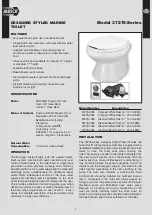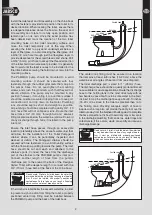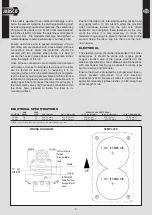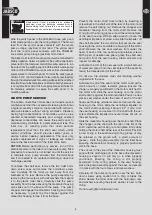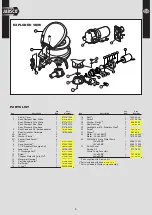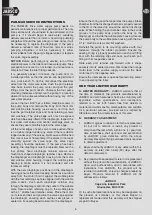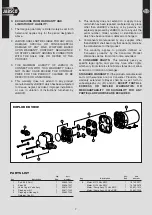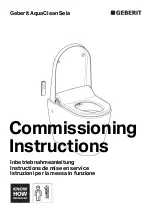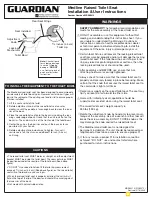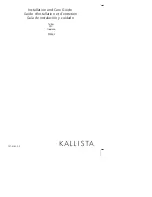
2
Install the toilet seat and lid assembly on the china bowl
with the fasteners provided and position the toilet in its
desired location. When locating the toilet, ensure there
is adequate clearance above the bowl so the seat and
lid assembly can rotate to its fully open position and
remain open on its own. Once the exact position has
been determined, mark the location of the two toilet
mounting holes on the toilet mounting surface and
move the toilet temporarily out of the way. When
securing the toilet to a plywood underlayment below a
layer of fiberglass, to avoid cracking the fiberglass, drill
a 5/16
"
(8 mm) hole through just the fiberglass layer to
provide clearance for the screw threads and shank. Drill
a 3/16
"
(5 mm) pilot hole to accept the threaded portion
of the toilet hold down screw set provided. It is generally
best to wait until the toilet is ready to be installed for the
final time before screwing the hold down screws into the
mounting surface.
The PAR-MAX pump should be mounted to a solid
mounting surface. It should be secured with four
fasteners through the rubber grommets that snap into
the pump’s base. Do not over-tighten the mounting
screws and crush the grommets such that they will not
absorb vibration. The pump may be mounted in any
position; however, if mounting it to a vertical surface it
should be oriented so water dripping from a loose port
connection will not drip down on the motor. Plumbing
runs should be kept as short and straight as possible.
All plumbing should be completed with quality 3/4
"
(19
mm) hose that will not collapse or kink. Route the inlet
hose from a 3/4" (19 mm) through hull and seacock
fitting located well below the waterline (and well forward
of any discharge through hulls, if installed) to the pump
inlet port.
Ensure the inlet hose passes through an accessible
location (preferably above the vessel’s water-line) that
will allow for the installation of the Toilet Pumpgard
strainer where it can be periodically inspected and
cleaned of debris. The Pumpgard strainer should be
secured with two fasteners to a solid mounting surface
with the flow arrow pointing towards the pump. The inlet
hose should be cut and each end attached to the
strainer’s ports. Connect the hose from the discharge
port of the strainer to the PAR-MAX pump’s inlet port.
Connect another length of hose from the pump’s
discharge port to the area at the back of the Designer
Styled Toilet with adequate length to connect with the
3/4
"
(19 mm) hose barb at the back of the china bowl.
DANGER
!
cAUTION
!
WARNING
!
WARNING
Flood hazard. If toilet is installed below the waterline
or may be below the waterline at any angle of heel or
trim, it must be intalled with properly positioned
vented loops. Failure to do so can result in flooding
which can cause loss of property and life.
If the toilet is installed below the vessel’s waterline, in order
to prevent a siphon action from filling the toilet, a properly
positioned vented loop fitting must be installed between
the PAR-MAX pump and the back of the toilet bowl.
The vented loop fitting must be secured in a location
that remains at least 6-8 inches (15-20 cm) above the
waterline at all angles of heel and trim (see diagram).
The toilet discharge port is sized for 1
"
(25 mm) hose.
The discharge hose should be a quality grade reinforced
hose suitable for waste applications. Route the discharge
hose to the holding tank in the most direct way with as
few bends as possible. To retain some water in the bowl,
it is best to loop the discharge hose up about 8-10 inches
(15-20 cm) as close to the toilet as practical then on to
the holding tank. Providing adequate length of hose to
include such a loop also will provide the ability to move the
toilet out away from the bulkhead it butts against to complete
the hose connections. It is best to avoid any dips or low spots
in the discharge plumbing that can act as water traps and
collect waste. If this occurs, waste can solidify and cause a
discharge blockage.
DANGER
!
cAUTION
!
WARNING
!
WARNING
Flood hazard. If toilet is installed below the waterline
or may be below the waterline at any angle of heel or
trim, it must be intalled with properly positioned
vented loops. Failure to do so can result in flooding
which can cause loss of property and life.
Heeled
Waterline
Waterline
Vented Loop
Heeled
Waterline
Waterline
Vented Loop

